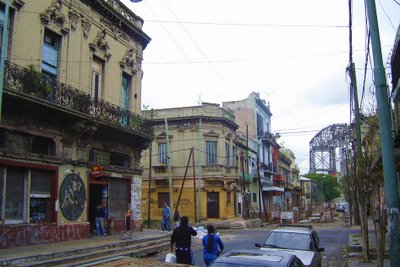
 One of the great things about Buenos Aires is that not only is it home to its own brand of the thrilling South American culture, its also brimming with thousands of immigrants and students from other Latin American countries. As a consequence there hundreds of bars, restaurants, cafes and clubs where nationals of a particular Latino nation have raised there flag and turned into a home-away-from-home.
One of the great things about Buenos Aires is that not only is it home to its own brand of the thrilling South American culture, its also brimming with thousands of immigrants and students from other Latin American countries. As a consequence there hundreds of bars, restaurants, cafes and clubs where nationals of a particular Latino nation have raised there flag and turned into a home-away-from-home.
Just the around the corner from where I live there is a Brazilian dance club, where young black, mulatto and white Brazilians sip caipirinhas and party till late the next morning. The same goes for the Colombian party held at least once a month in a club just up the road, only here the dance is the ballanato and the drink the awesomely powerful aguardiente. Peruvians, Bolivians and Paraguayans - of whom there are at least 1.5 million in Argentina - all have a great many social clubs and restaurants, where the menu not only differs according to nation but also according the region the cooks are from. Most of those however are located outside the city centre in accordance with the fact that most residents from these countries are here to work and not to party.
 The last two Sundays in a row I've visited one such restaurant - the comedor Ecuatoriana on Defensa street in San Telmo. I (we I should say because this Sunday I was accompanied by two friends, my Ecuadorian girlfriend of two weeks, Mariela a music student, and well-travelled James, who has trouble concealing his disappointment in Argentina and starts every sentence with "This is alright, but in Colombia/Ecuador/Brazil/Cuba you had these..." and then slowly drifts off as his eyes glaze over.) had heard about the place from an Ecuadorian we all met at a party a few weeks ago.
The last two Sundays in a row I've visited one such restaurant - the comedor Ecuatoriana on Defensa street in San Telmo. I (we I should say because this Sunday I was accompanied by two friends, my Ecuadorian girlfriend of two weeks, Mariela a music student, and well-travelled James, who has trouble concealing his disappointment in Argentina and starts every sentence with "This is alright, but in Colombia/Ecuador/Brazil/Cuba you had these..." and then slowly drifts off as his eyes glaze over.) had heard about the place from an Ecuadorian we all met at a party a few weeks ago.
 The visit entails a trip acrosss town from the more affluent neighbourhood Palermo, where I live, to the old heart of Buenos Aires San Telmo, just south of the city centre. Seeing as we were going that way anyway we decided to combine the visit with a trip to La Boca, the working class barrio near the port, famous for its colourful houses and Boca Juniors football club.
The visit entails a trip acrosss town from the more affluent neighbourhood Palermo, where I live, to the old heart of Buenos Aires San Telmo, just south of the city centre. Seeing as we were going that way anyway we decided to combine the visit with a trip to La Boca, the working class barrio near the port, famous for its colourful houses and Boca Juniors football club.
The touristy part of La Boca, that's to say the tiny area around Caminito where the houses are brightly coloured, turned out to be a bit of a let down. The rest of it however, with its run down colonial mansions housing large groups of families in various degrees of destitution, gives you an idea of what old Havana must be like.

The restaurant only opens on Sunday from one till five and is run by Ecuadorians from the north of the country, where the population is predominantly of African descent. During the rest of the week they run a dance school out of the same building.
 After months of Argentine cuisine, which is good though not exactly divers - its either slabs of meat, pizza or pasta - I was looking forward to some good cooking that demanded more than a parilla to prepare. The week before I'd had two excellent dishes. Ceviche, a kind of cold fish soup ram packed with all sorts of seafood and Guatita, a delicious yellow sauce made with parts of cow stomach. Interesting.
After months of Argentine cuisine, which is good though not exactly divers - its either slabs of meat, pizza or pasta - I was looking forward to some good cooking that demanded more than a parilla to prepare. The week before I'd had two excellent dishes. Ceviche, a kind of cold fish soup ram packed with all sorts of seafood and Guatita, a delicious yellow sauce made with parts of cow stomach. Interesting.
This weeks menu consisted of either menestra - a bean sauce served with rice and chicken or fritada, which are fried pieces of pork. Mariela and James, both of whom were overcome by a severe bout of nostalgia ordered the beans, leaving me to opt for pork, a welcome change from steaks. 
Not a bad choice it turned out, because the meat was served with mote, a kind of Ecuadorian chick pea (I think), and toasted maize. I tasted some of their beans, which weren't bad either. All in all, just another great reason to go to Ecuador.
The show, even among Ecuadorians, isn't over till the fat lady does something to draw attention to herself - in this case some first class hip swinging action. For no sooner had we finished our plates than some tables were cleared away and the real Esmeraldeña spirit - as the northerners are called - was on display. Drums beat, voices called, hips rocked and we almost forgot we were in urban European Buenos Aires on a cold autumn day. Which is what being in Buenos Aires is really all about.

 Juan Diego, Victor, Esteban - the three Colombians I lived with in het hotel on Av. Santa Fe - and myself chose to pool our resources and rent an apartment. They shopped around for a few weekends and came up with our new place on México street, nr. 2245. It's big, it's got everything and best of all it's cheap.
Juan Diego, Victor, Esteban - the three Colombians I lived with in het hotel on Av. Santa Fe - and myself chose to pool our resources and rent an apartment. They shopped around for a few weekends and came up with our new place on México street, nr. 2245. It's big, it's got everything and best of all it's cheap. Just across the road there's an immense supermarket, which is convenient seeing as I want to cut down on my eating out budget. But then on the corner there's a restaurant that serves a hot meal for 6 pesos or 1,7 euros, so maybe I'll still get to eat lunch out a few days.
Just across the road there's an immense supermarket, which is convenient seeing as I want to cut down on my eating out budget. But then on the corner there's a restaurant that serves a hot meal for 6 pesos or 1,7 euros, so maybe I'll still get to eat lunch out a few days. 

















